24 December 2022
The Last Volcano, by John Dvorak
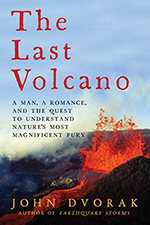 A new week, a new nonfiction geology book by John Dvorak! This one is a biography of Thomas Jaggar, who founded the Hawaiian Volcano Observatory. It was a really interesting portrait of a man driven to spend time with erupting mountains. The book begins with the eruption of Mt. Pelee in Martinique, a harrowing pyroclastic flow that kills almost everyone in St. Pierre. The son of a bishop, young Jaggar realizes there are potentially huge benefits to monitoring volcanoes for signs of eruption. Lives could be saved through the application of geophysical science at these discrete sites around the world. He journeys to Vesuvius, Yellowstone, Japan, and Alaska, but ultimately finds his purpose at Kilauea, on the big island of Hawaii. Jaggar’s big idea is that we won’t know what’s going on with a volcano unless we establish a baseline dataset, and that takes dedicated staff and equipment, and that takes (government) funding. The HVO started with MIT, then became part of the Weather Bureau, then the National Park Service, and nowadays resides under the USGS. At the start, there was plenty of wheeling and dealing and networking in order to get the observatory established, and one of the unexpected insights of the book was a primer on the colonial history of Hawaii, particularly the substantial influence of Lorrin Thurston, a businessman and politico who seems to have been just as critical as Jaggar in getting the observatory established and maintained. (Thurston’s motivations were very different, though.) Through years and years of making daily observations, Jaggar determined that earthquake swarms presage eruptions, that there are long-term cycles of inflation and deflation of the volcano as magma moves through its system of reservoirs. He also made the first tsunami warning based on seismology, a practice that saves lives to this day. Dvorak devotes ample coverage to Jaggar’s family/romantic life, as well, in particular the synergy Jaggar found with his second wife, who became integrated into his scientific practice at Kilauea. All told, it made me impressed with how one person’s legacy can echo through the subsequent decades as a positive force. The USGS, in partnership with other institutions, now manages five volcano observatories in the United States, a fact that should comfort every citizen, including those looking for ways to trim the federal budget.
A new week, a new nonfiction geology book by John Dvorak! This one is a biography of Thomas Jaggar, who founded the Hawaiian Volcano Observatory. It was a really interesting portrait of a man driven to spend time with erupting mountains. The book begins with the eruption of Mt. Pelee in Martinique, a harrowing pyroclastic flow that kills almost everyone in St. Pierre. The son of a bishop, young Jaggar realizes there are potentially huge benefits to monitoring volcanoes for signs of eruption. Lives could be saved through the application of geophysical science at these discrete sites around the world. He journeys to Vesuvius, Yellowstone, Japan, and Alaska, but ultimately finds his purpose at Kilauea, on the big island of Hawaii. Jaggar’s big idea is that we won’t know what’s going on with a volcano unless we establish a baseline dataset, and that takes dedicated staff and equipment, and that takes (government) funding. The HVO started with MIT, then became part of the Weather Bureau, then the National Park Service, and nowadays resides under the USGS. At the start, there was plenty of wheeling and dealing and networking in order to get the observatory established, and one of the unexpected insights of the book was a primer on the colonial history of Hawaii, particularly the substantial influence of Lorrin Thurston, a businessman and politico who seems to have been just as critical as Jaggar in getting the observatory established and maintained. (Thurston’s motivations were very different, though.) Through years and years of making daily observations, Jaggar determined that earthquake swarms presage eruptions, that there are long-term cycles of inflation and deflation of the volcano as magma moves through its system of reservoirs. He also made the first tsunami warning based on seismology, a practice that saves lives to this day. Dvorak devotes ample coverage to Jaggar’s family/romantic life, as well, in particular the synergy Jaggar found with his second wife, who became integrated into his scientific practice at Kilauea. All told, it made me impressed with how one person’s legacy can echo through the subsequent decades as a positive force. The USGS, in partnership with other institutions, now manages five volcano observatories in the United States, a fact that should comfort every citizen, including those looking for ways to trim the federal budget.
15 December 2022
Beasts Before Us, by Elsa Panciroli
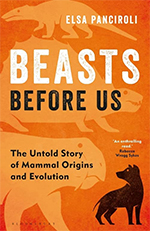 So many books have been written about dinosaurs, but this one looks at a deeper history of another important group: our own. Beasts Before Us is “the untold story of mammal origins and evolution.” The Cenozoic is often dubbed “the age of mammals,” but the story of our hairy, milk-guzzling brethren goes much deeper into geologic time. There have sort of been two ages of “mammals,” author paleontologist Elsa Panciroli points out. The first was in the late Paleozoic, when the terrestrial realm was “dominated” by synapsids. Ultimately, these animals were ancestral to the line of evolutionary descent that became mammals. They were their own entity, though they are often dubbed “mammal-like reptiles,” Panciroli makes the case that “reptile-like mammals” might be a better descriptor. I really enjoyed the deep, detailed discussion exploring the various proposed explanations for the sails on the backs of certain synapsids, such as Dimetrodon and Edaphosaurus. Were they for thermoregulation, fat storage support, sexual display, or defense? Panciroli explores the pros and cons of each idea. It was refreshingly robust. She follows the evolutionary story into the Mesozoic, when crocodilians and then dinosaurs “take over” the land, but mammals and their ancestors were surprisingly common and diverse, if not as robustly represented in the fossil record. Panciroli relates tales of her research in various parts of the world, but particularly on the Isle of Skye in Scotland. Her perspective is fresh and enthusiastic, which helps compensate for the (to me) bewildering array of paleontological and anatomical jargon. The book is infused with a social and political perspective that could be dubbed “woke,” with significant attention paid to the colonialism, racism, and sexism that unfortunately permeated paleontology’s earlier years, and whose legacy haunts us still. She also devotes book-conclusion attention to what may be the most significant aspect of mammal evolution – that one of their species has rapidly transferred a large portion of the planet’s fossil carbon back into its atmosphere, with effects that will be felt all over the planet for a long time to come. There were a few small errors that better editing would have caught – substituting “Mohican” for “Mohawk,” for instance. Another that will rankle geochemists is abbreviating uranium as “Ur” rather than “U.” I read the first edition, hardcover, so that sort of thing may be cleaned up in subsequent printings.
So many books have been written about dinosaurs, but this one looks at a deeper history of another important group: our own. Beasts Before Us is “the untold story of mammal origins and evolution.” The Cenozoic is often dubbed “the age of mammals,” but the story of our hairy, milk-guzzling brethren goes much deeper into geologic time. There have sort of been two ages of “mammals,” author paleontologist Elsa Panciroli points out. The first was in the late Paleozoic, when the terrestrial realm was “dominated” by synapsids. Ultimately, these animals were ancestral to the line of evolutionary descent that became mammals. They were their own entity, though they are often dubbed “mammal-like reptiles,” Panciroli makes the case that “reptile-like mammals” might be a better descriptor. I really enjoyed the deep, detailed discussion exploring the various proposed explanations for the sails on the backs of certain synapsids, such as Dimetrodon and Edaphosaurus. Were they for thermoregulation, fat storage support, sexual display, or defense? Panciroli explores the pros and cons of each idea. It was refreshingly robust. She follows the evolutionary story into the Mesozoic, when crocodilians and then dinosaurs “take over” the land, but mammals and their ancestors were surprisingly common and diverse, if not as robustly represented in the fossil record. Panciroli relates tales of her research in various parts of the world, but particularly on the Isle of Skye in Scotland. Her perspective is fresh and enthusiastic, which helps compensate for the (to me) bewildering array of paleontological and anatomical jargon. The book is infused with a social and political perspective that could be dubbed “woke,” with significant attention paid to the colonialism, racism, and sexism that unfortunately permeated paleontology’s earlier years, and whose legacy haunts us still. She also devotes book-conclusion attention to what may be the most significant aspect of mammal evolution – that one of their species has rapidly transferred a large portion of the planet’s fossil carbon back into its atmosphere, with effects that will be felt all over the planet for a long time to come. There were a few small errors that better editing would have caught – substituting “Mohican” for “Mohawk,” for instance. Another that will rankle geochemists is abbreviating uranium as “Ur” rather than “U.” I read the first edition, hardcover, so that sort of thing may be cleaned up in subsequent printings.
9 December 2022
Pillbug tracks in ash from Mt. St. Helens
Reader Nancy Weidman (who supplied the Wind River boudinaged basaltic dike images from earlier in the week) sent me this interesting note:
Your ichnoanalogue post reminds me of the insect or pillbug tracks I found in Mt. St. Helens ash deposited in Missoula, Montana. At least some of the tracks, if I recall correctly, ended in dead bugs, presumably dead after its breathing tubes clogged with ash. No fossils from these – the sidewalks were swept clean without a chance to fossilize. The attached photos are from the day after the eruption and are from scanned 35m slides.


So cool!!
Incidentally, this was a momentous moment of my youth – I know what I was doing on this day. I remember coming in from playing outside and seeing that day’s Washington Post in the trash can (this was before widespread recycling) and the bold headline stretching across the entire width of the paper about Mount St. Helens’ eruption. It’s the first “big event” I remember growing up. I guess I would have been 5½ years old? It made an impression on me – I’d never seen a newspaper headline that big before. Maybe something in that moment, mixing the public outreach of journalism and the drama of geology, imprinted itself on me (like these pillbug feet in the ash) and led to this moment, with me geo-blogging!
7 December 2022
The coastal section at Esterillos Oeste, Costa Rica
As mentioned, over Thanksgiving I got the opportunity to travel to Costa Rica, to the little beach town of Esterillos Oeste. I really enjoyed the sloths and toucans and geckos, but two of my favorite jaunts were solo explorations along a substantial wave-cut platform west of the town beach. These rocks are submerged at high tide, but exposed at low tide. The rock outcrops run for ~3.5 km along the beach, in a strip that’s about 200 m wide from the beach to the crashing waves at low tide. In exploring them, I found that many of the outcrops were slippery, coated with a gelatinous scuzz of biofilm. Twice, I nearly wiped out when attempting to cross a slick knoll. But I had such a good time, exploring solo on an unpopulated stretch of coast. That’s my idea of heaven: interesting rocks, no people, and just a few interesting birds for company (e.g., bare-throated tiger heron!!).
I have since learned that the formation is the Punta Judas Formation, and it has been determined to be middle Miocene in age. Apparently it contains a decent number of shark fossils, though I didn’t see any.
Let me recount the strata I observed, working my way westward from La Sirena, a statue of a mermaid where Esterillos’s beach turns to rock, heading down-section as I traveled further toward Punta Mala. Here’s a map showing the route. It’s an east-west section of coast, with the Pacific Ocean to the south. I’ve dropped on four strike/dip symbols showing the orientation of the strata, but caveat emptor: I didn’t do any systematic mapping or measuring of section.
Let’s check out what I found in the easternmost outcrops (youngest strata). They were volcaniclastic sands, and I spotted a few planar cross-beds, but then I saw this:
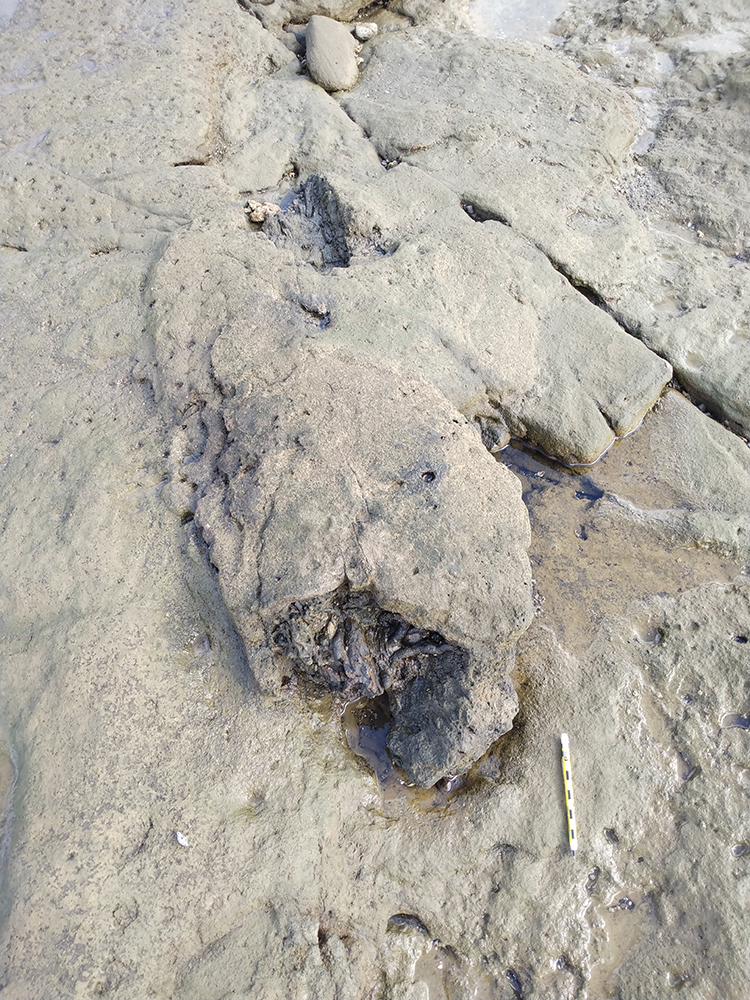
Here’s a close-up of that front section:

I’m pretty sure that’s a big fossil palm tree trunk! It was overall cylindrical and several feet long, and had these internal wiggly rootlet looking things. I wasn’t sure what I was getting into with exploring these strata, but the lack of shelly marine fossils, and then this tree trunk made me to provisionally interpret the easternmost (youngest) part of the section as terrestrial, or at least shoreline proximal (like a deltaic setting).
I don’t have a ton of photos of that easternmost section, but a short distance down-section, the strata looked like this:

… thick beds of coarse sand and pebbles, with planar cross-beds.
A couple of graded beds (with “paleo-up” to the left):

But is there any evidence of marine influence? …
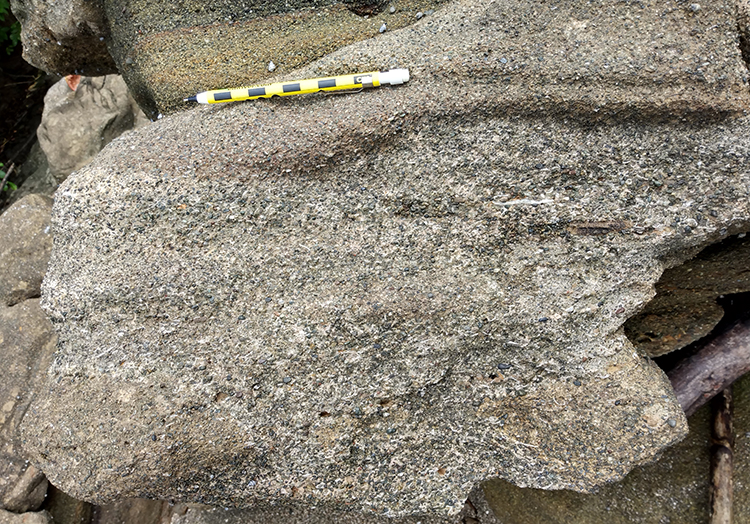
Closer up, I started to see what looked like shelly material beginning to show up not very far down into the section.
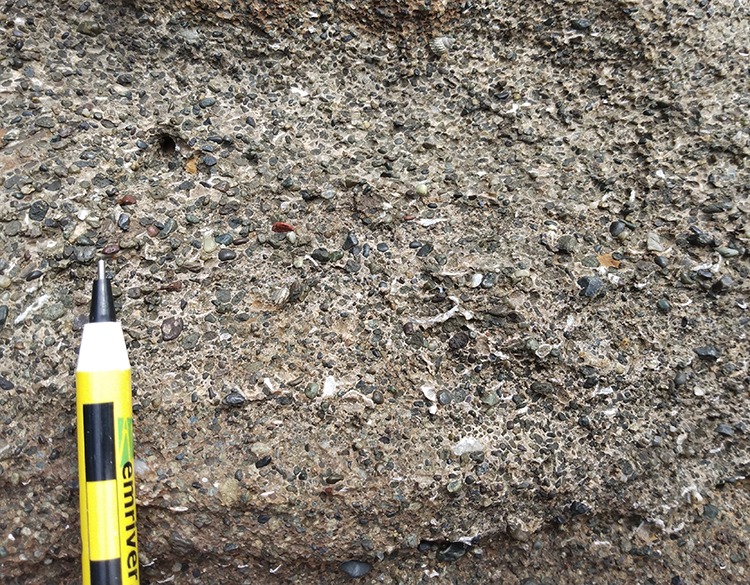
Okay, that’s for sure a fossil – a scallop, I guess?
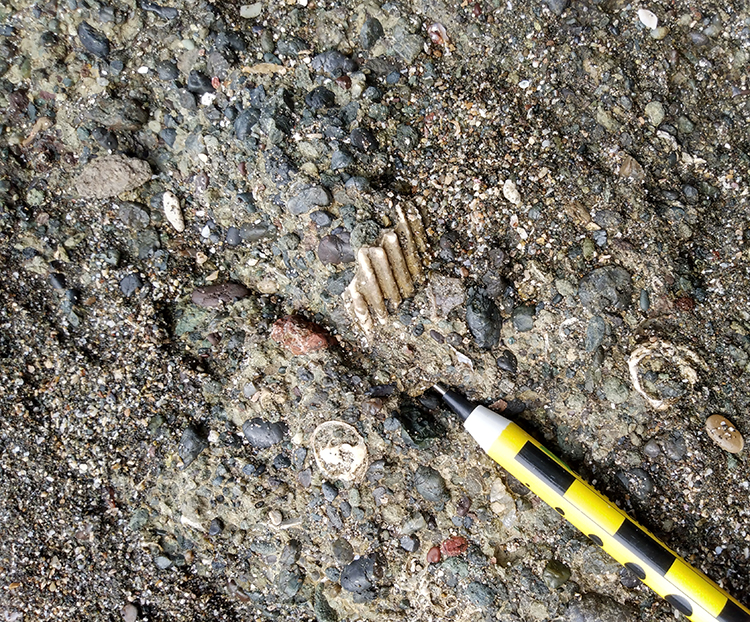
Here’s a bivalve (~clam) fossil in coarse volcaniclastic sediment, but filled with a body of much finer sediment.

And I was able to pluck one out:
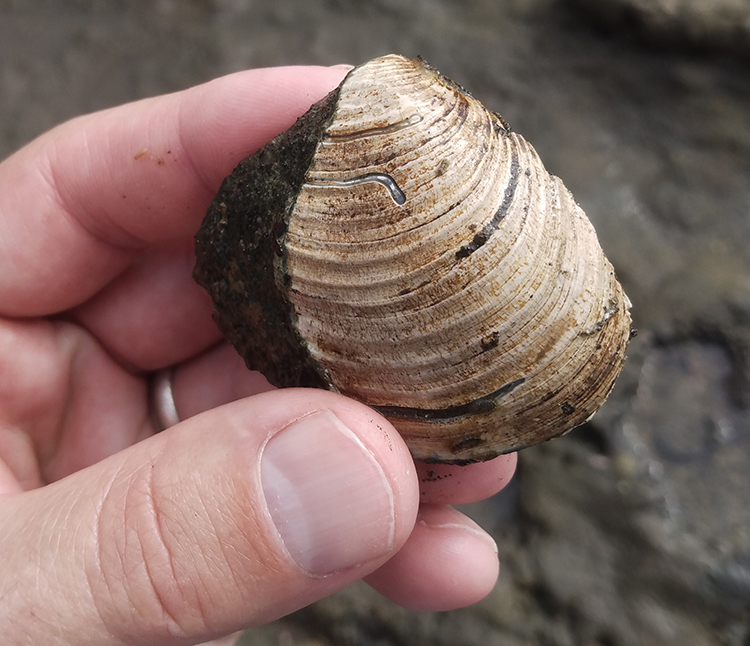
A suite of gastropod (snail) fossils:


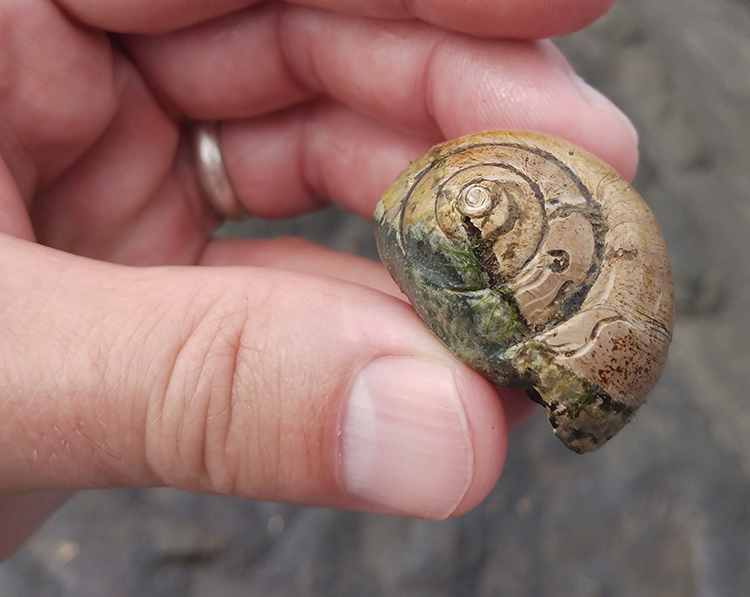
The sediment got finer: a mudrock. In it, there were also plenty of diagenetic features, like boxwork along joints, and these concretions:
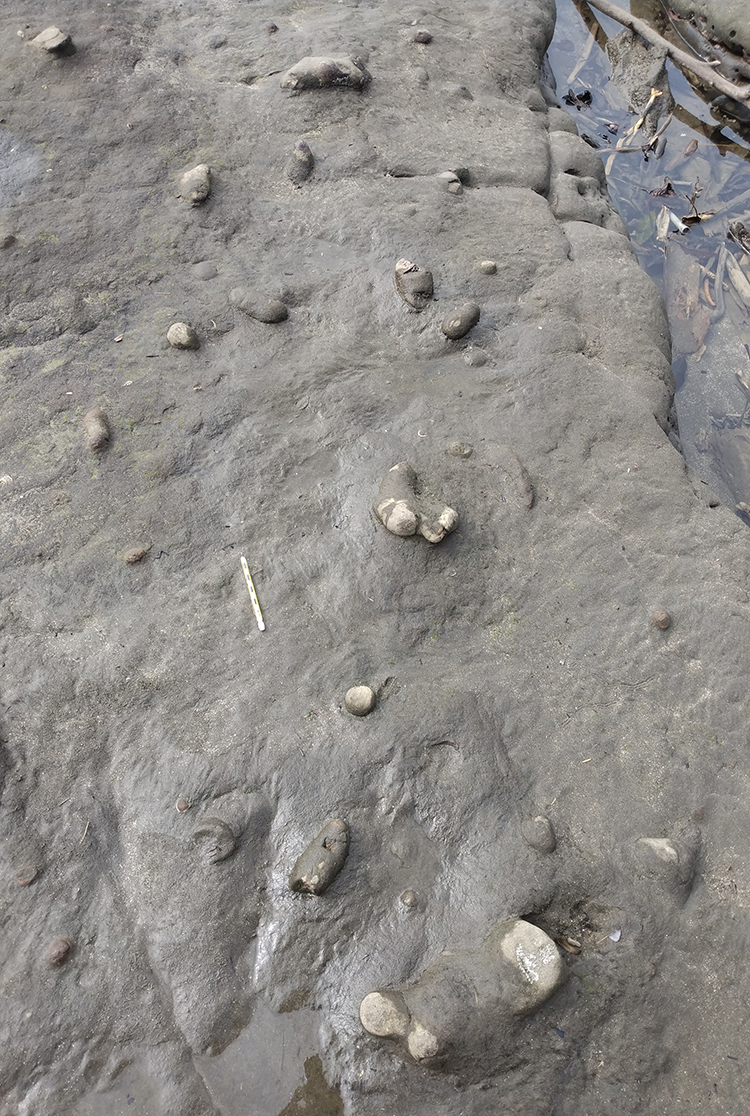
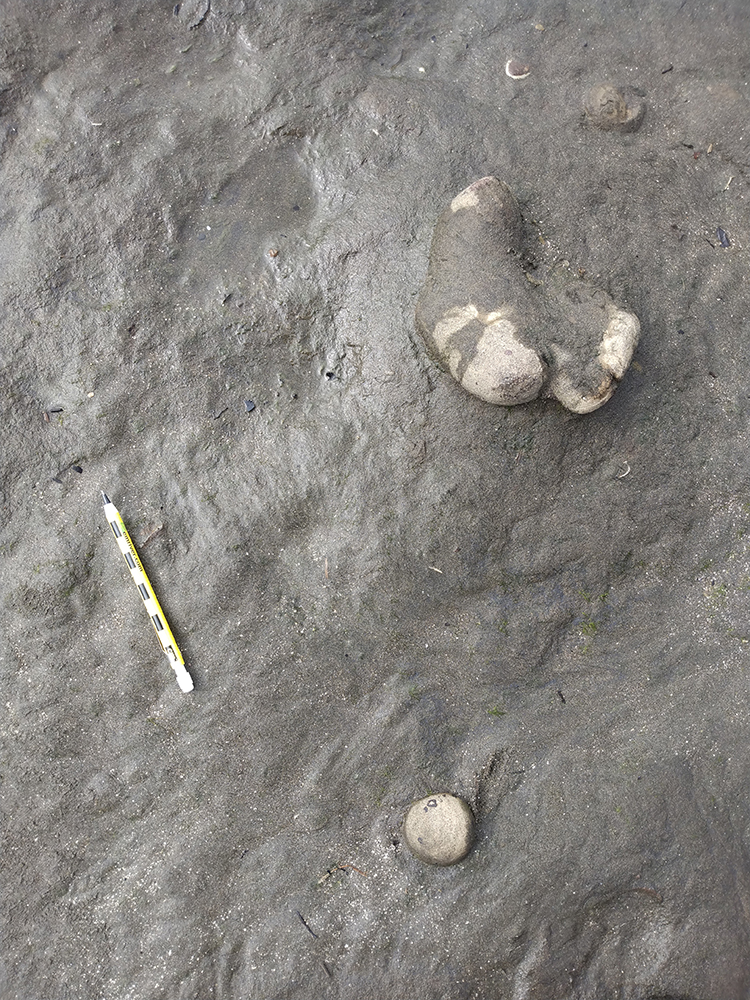
This is neat example showing differential weathering of the concretions multiple concentric spheres:
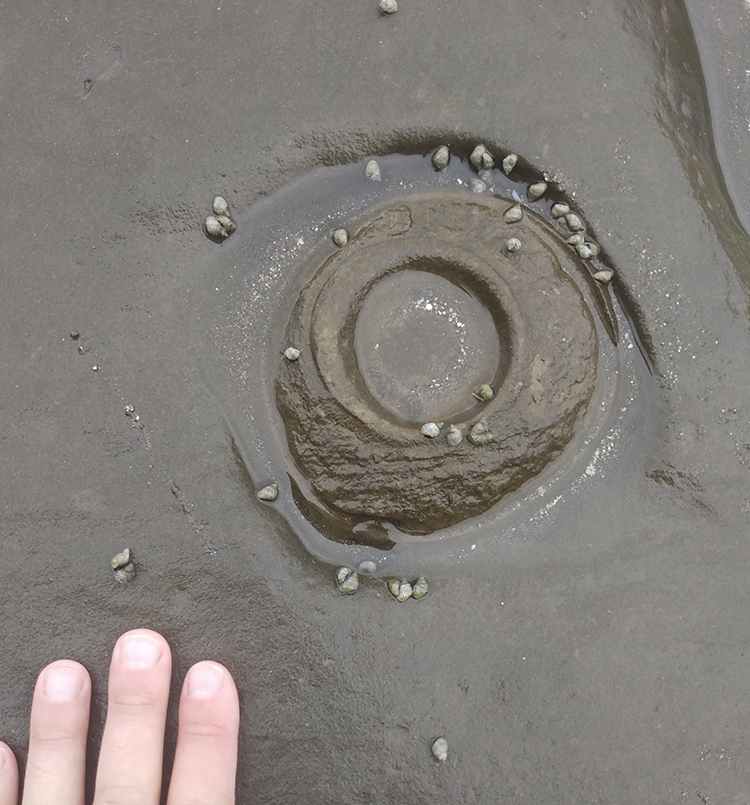
Then the sediments got coarse again, but a different kind of coarse… a bioclastic coarse:
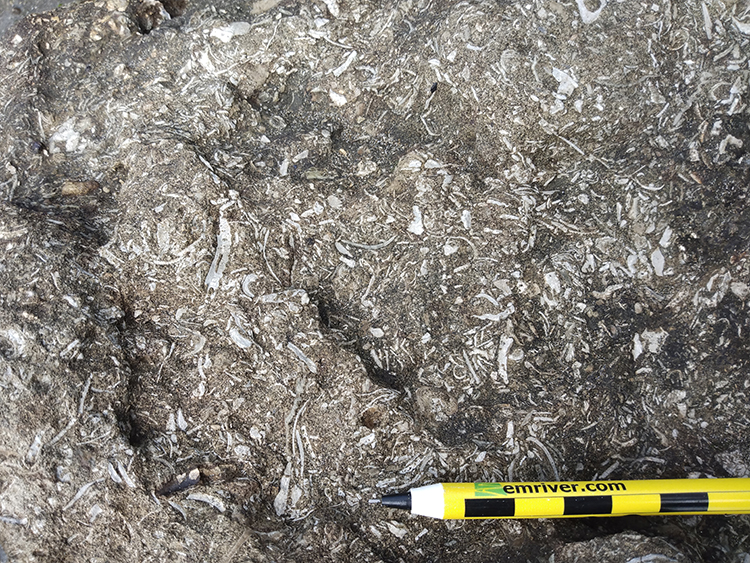
Then back to sand, but with shell-filled burrows, like this one (plan view):
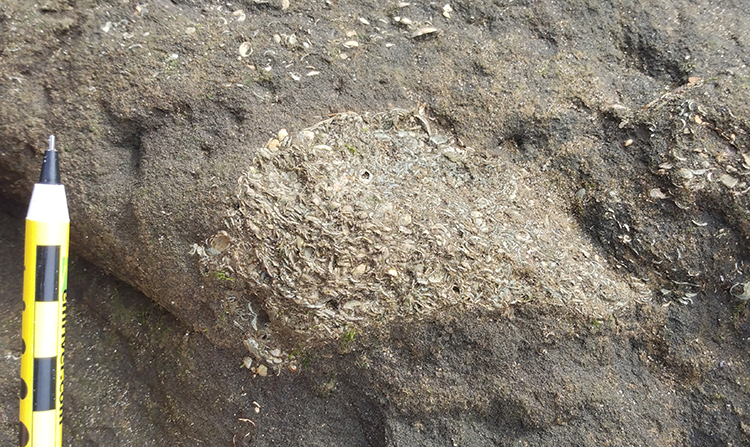
Or this one, which is pleasingly circular (despite being a bit submerged):

Or this one (side view):

Or this one, which I love because its internal “fabric” shows backfilling, presumably as sediment was accumulating above and the burrow occupant had to keep up with the rising seafloor surface:
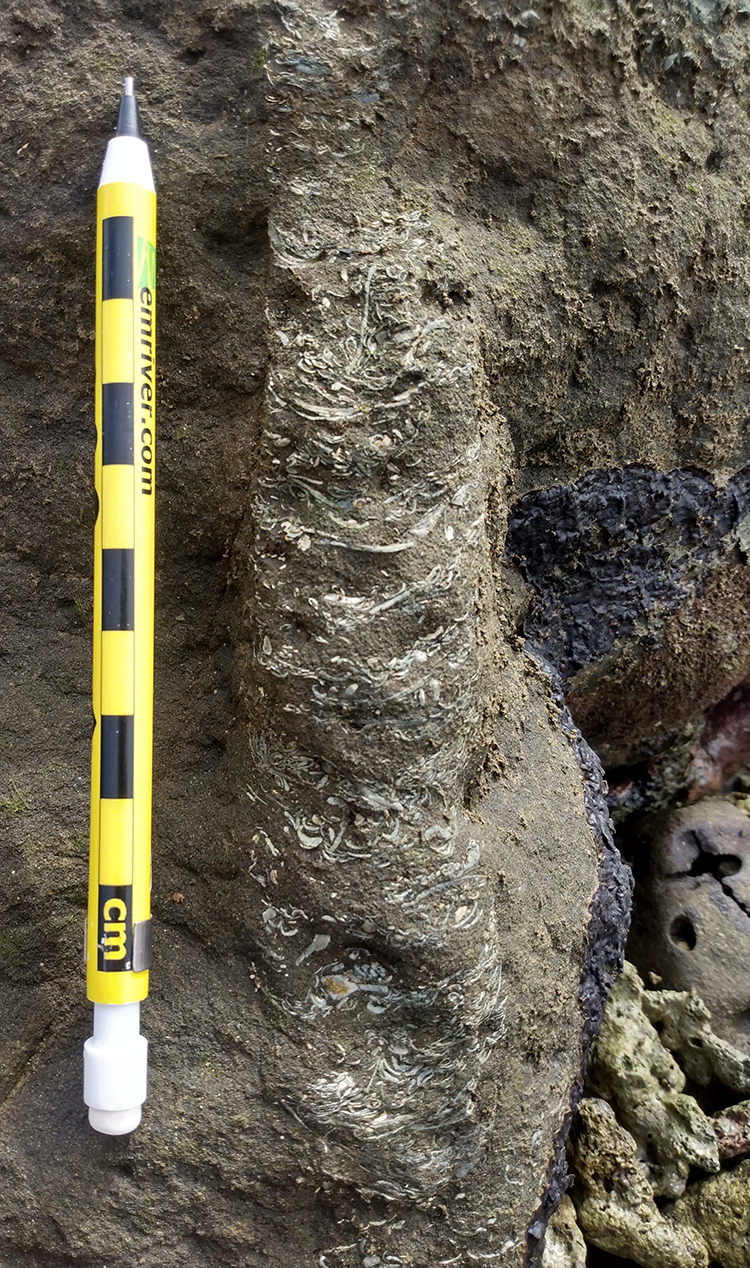
More sand, and with it another layer of buried bivalves, in this case (based on the articulation of the two valves) a group of clams that were buried alive:
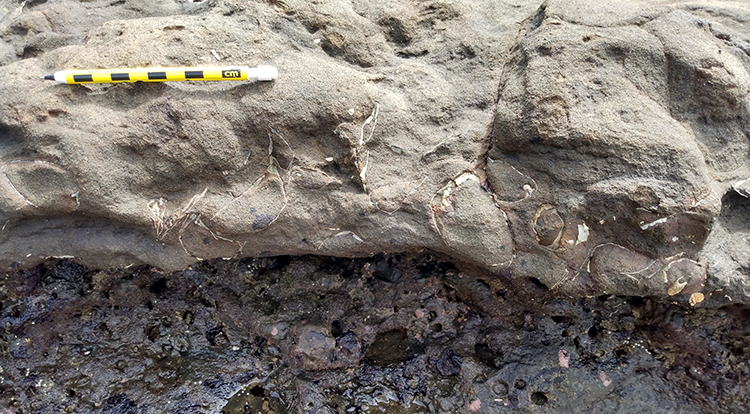
I found a few high-spiraled snails, Turitella or a related genus, presumably:
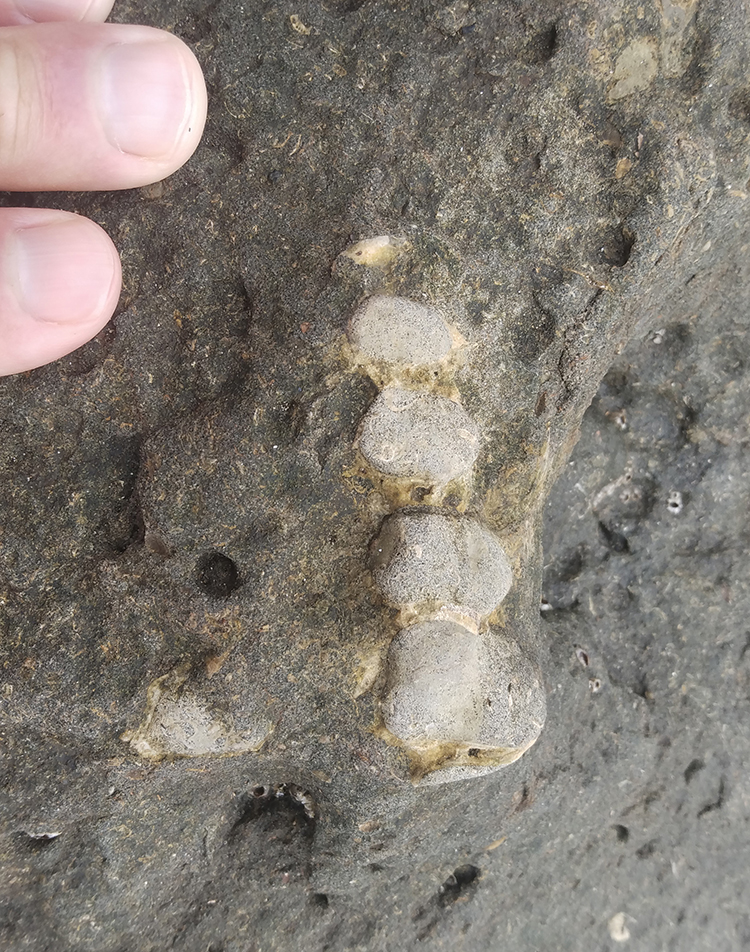
Two more examples, with original skeletal material:
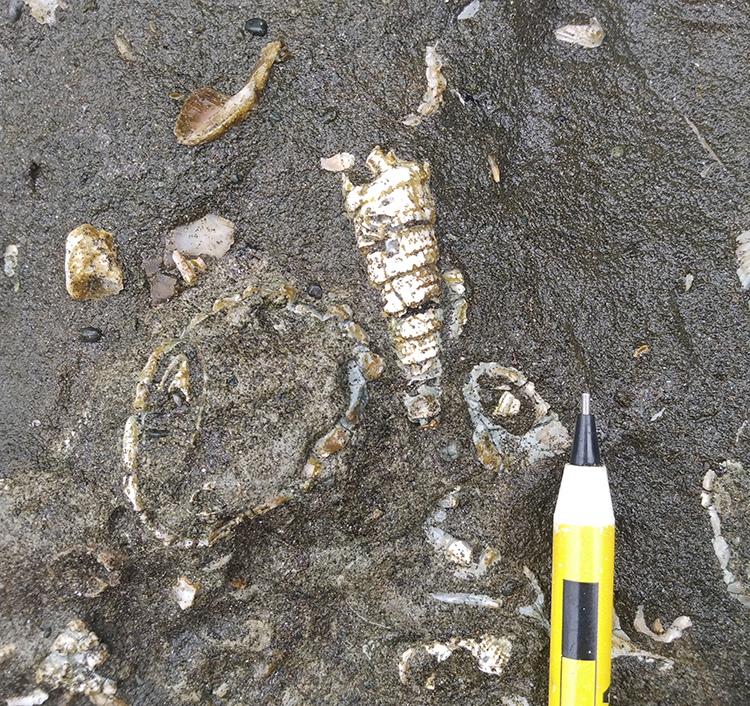

A few small diameter sinuous trace fossils:
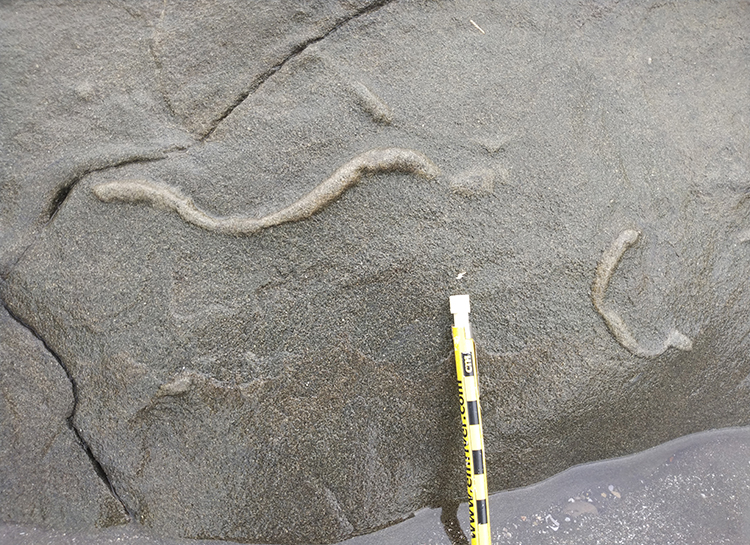
Another primary sedimentary structure here: rip-up clasts of mud, set in a sandy matrix (with a fair amount of coalified plant scraps):

The story with the rip-ups is (1) initial low-energy deposition of mud followed by (2) a high-energy event that both (a) ripped up the mud in self-cohesive chunks and (b) entrained a lot of sand, mixing the two for the final deposit.
A similar story can be seen below, with a sandy layer between muddy layers, but here including some disarticulated bivalve shells as well. Notice how all the shells have a consistent orientation, concave-down: that’s another good paleo-up indicator:

Another primary sedimentary structure I saw in abundance, that served as a good indicator of marine sub-normal-wave-base conditions (but within reach of storm waves) and one that also serves as a paleo-up indicator, is hummocky cross-stratification:
Here’s another example:

A neat outcrop showing hummocky cross-stratification (right), plus a concretion and the “tafoni” style of modern salt-enhanced weathering:

[Annotated:]
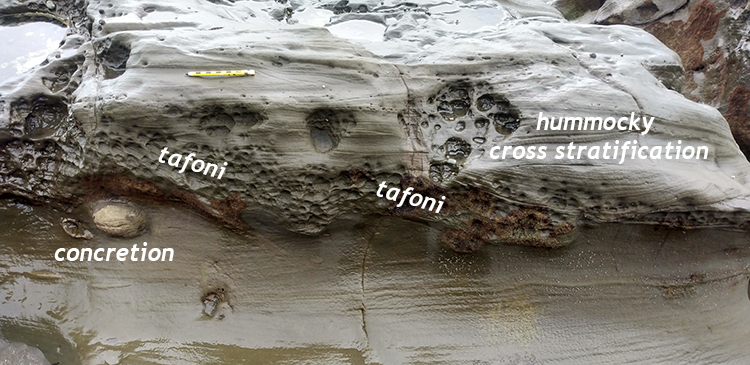
One more example, bearing a mix of shells and gray sand laid out in neat cross-laminations:
Closer up, so you can see the internal cross-laminations, defined nicely by the shelly components of the sediment (cross-beds dip to the right, which is south in this case). Note also the more extremely incised “bite” just to the right of the pencil’s eraser-end, and how coarse the material filling that incision is:
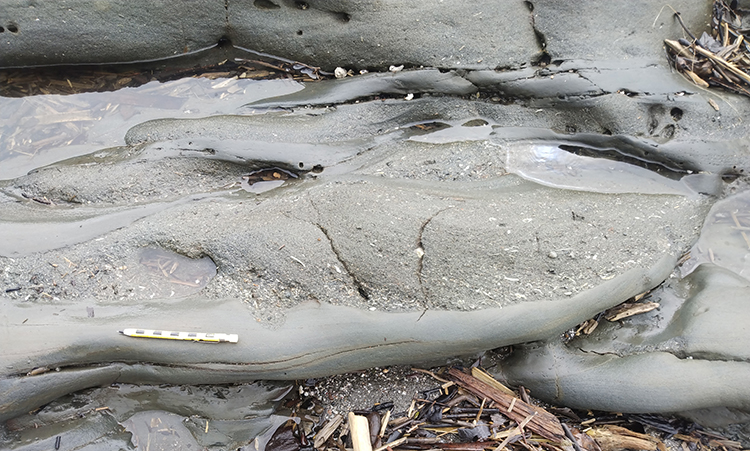
Finally, all of these *awesome* sedimentary layers were deformed. There were large-scale folds (as seen in the satellite image above), but also a substantial number of brittle faults with small offsets. Here’s one:
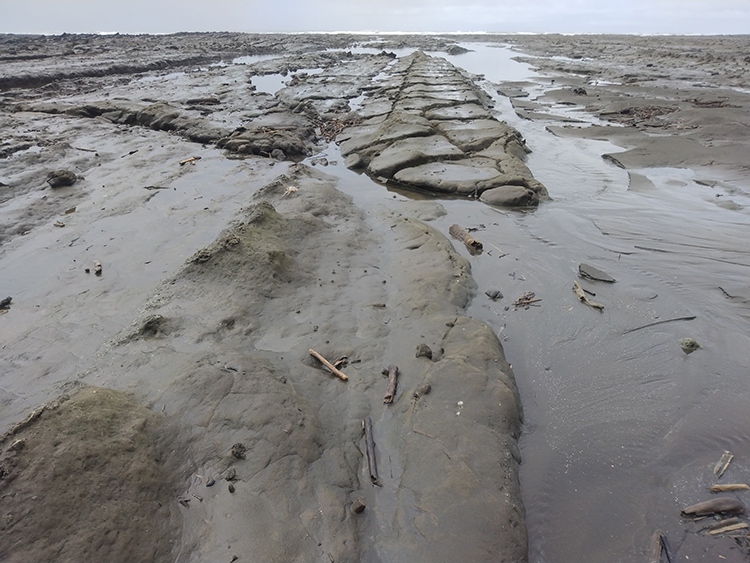
Here’s a conjugate pair of faults offsetting a shell-rich layer into a nice triangular pop-out structure that thickens the rock package east-west, and shortens it north-south. (The view here is looking south):
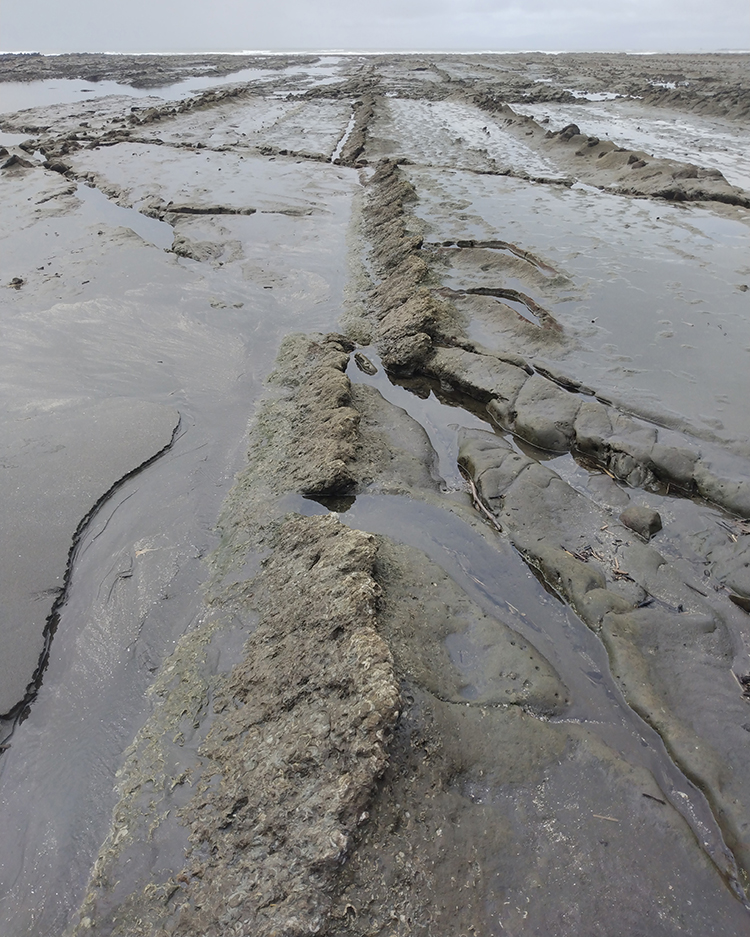
You can see these faults easily if you zoom into the Google Earth screenshot I provided earlier:
Between the sedimentology, the fossils, the diagenetic structures, the structural deformation, and the modern weathering, this site was a real treat to explore. I wonder if I can take students there someday…? I think it would make an awesome intro mapping project.
5 December 2022
Mafic blocks in Wind River Range granite
Got these photos from a reader, showing outcrops in the northern Wind River range (ESE of Island Lake). The question, inevitably, is are these MMEs (microgranular mafic enclaves) or xenoliths?
They’re fine grained and mafic… but some lithologies of xenolith could be too!
This next set shows what appear to be a bunch of blocks strung out in a line…
This one is shaped like a toaster or a television set:
Note that more pronounced weathering of the mafic blocks, and also how the granite’s fabric wraps around it on at least three sides.
Any thoughts, igneous petrologists?
2 December 2022
Friday fold: Hidden Rock Park, Goochland County
Two weeks ago was the annual Virginia Geological Field Conference, which was centered this year on the Goochland Terrane, an interesting block of crust in the Piedmont which shows some similarities to the Blue Ridge geologic province, but also shows some differences that suggest it’s not just a mini-Blue-Ridge. One of the best exposures was in Hidden Rock Park, where a series of “whaleback” outcrops expose things like this:

There, a granite dike cuts through a gneiss, and then that granite dike is folded and boudinaged. Annotated:
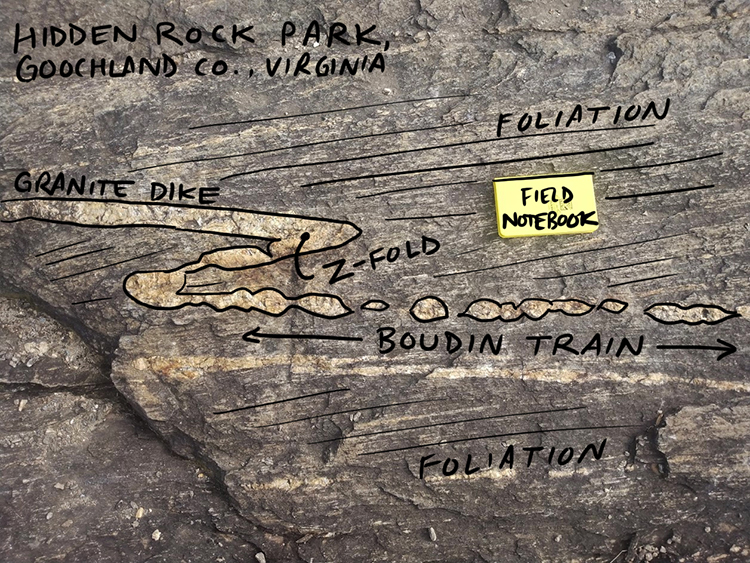
Happy Friday!
1 December 2022
Mask of the Sun, by John Dvorak
 Inspired by How The Mountains Grew, I ordered the rest of John Dvorak’s oeuvre recently. I read the first over Thanksgiving break – a great nonfiction look at eclipses. The basics of lunar and solar eclipses are dispensed with early on, and Dvorak then spends his time on understanding of eclipses in antiquity, the gradual accumulation of insight into the causes and timing of eclipses – thus permitting them to be forecast, and how this understanding came part and parcel with newfound scientific insights about the nature of the solar system in general. The influence of eclipses on history and literature is explored next, and the many tales of adventurous travel to go to a place where eclipse observations are to be made, sometimes successfully and just as often ending in failure due to an inopportune cloudy sky. Emily Dickinson, Albert Einstein, and Christopher Columbus all make appearances, but the most attention is given to the astronomers who made key advances in advancing humanity’s understanding of this amazing phenomenon, and how they cleverly answered questions such as whether there is a planet inside Mercury’s orbit, or what the nature of the corona might be. And because the phenomenon invariably triggers awe and wonder, a fair amount of attention is given to the experiential nature of eclipse viewing, as well as the phenomenology of those few minutes. (There is a particularly hilarious anecdote about Thomas Edison being besieged by chickens coming home to roost in the sudden darkness of a solar eclipse, messing up the experiment he has inadvertently set up in their coop.) Dvorak makes the point that our planet is pretty much unique in the eclipses it experiences. Further, this moment in time is pretty much perfect for solar eclipses, but in the future the Moon will slip further away from Earth, and thus won’t be able to completely “cap” the sun any more. There will be a “last eclipse” someday in the far future – so enjoy them while you can.
Inspired by How The Mountains Grew, I ordered the rest of John Dvorak’s oeuvre recently. I read the first over Thanksgiving break – a great nonfiction look at eclipses. The basics of lunar and solar eclipses are dispensed with early on, and Dvorak then spends his time on understanding of eclipses in antiquity, the gradual accumulation of insight into the causes and timing of eclipses – thus permitting them to be forecast, and how this understanding came part and parcel with newfound scientific insights about the nature of the solar system in general. The influence of eclipses on history and literature is explored next, and the many tales of adventurous travel to go to a place where eclipse observations are to be made, sometimes successfully and just as often ending in failure due to an inopportune cloudy sky. Emily Dickinson, Albert Einstein, and Christopher Columbus all make appearances, but the most attention is given to the astronomers who made key advances in advancing humanity’s understanding of this amazing phenomenon, and how they cleverly answered questions such as whether there is a planet inside Mercury’s orbit, or what the nature of the corona might be. And because the phenomenon invariably triggers awe and wonder, a fair amount of attention is given to the experiential nature of eclipse viewing, as well as the phenomenology of those few minutes. (There is a particularly hilarious anecdote about Thomas Edison being besieged by chickens coming home to roost in the sudden darkness of a solar eclipse, messing up the experiment he has inadvertently set up in their coop.) Dvorak makes the point that our planet is pretty much unique in the eclipses it experiences. Further, this moment in time is pretty much perfect for solar eclipses, but in the future the Moon will slip further away from Earth, and thus won’t be able to completely “cap” the sun any more. There will be a “last eclipse” someday in the far future – so enjoy them while you can.
30 November 2022
Ichnoanalogue
Another glimpse of sand on the beach at Esterillos Oeste, Costa Rica…
This time, I offer you a trace of an organism moving through the wet sediment:
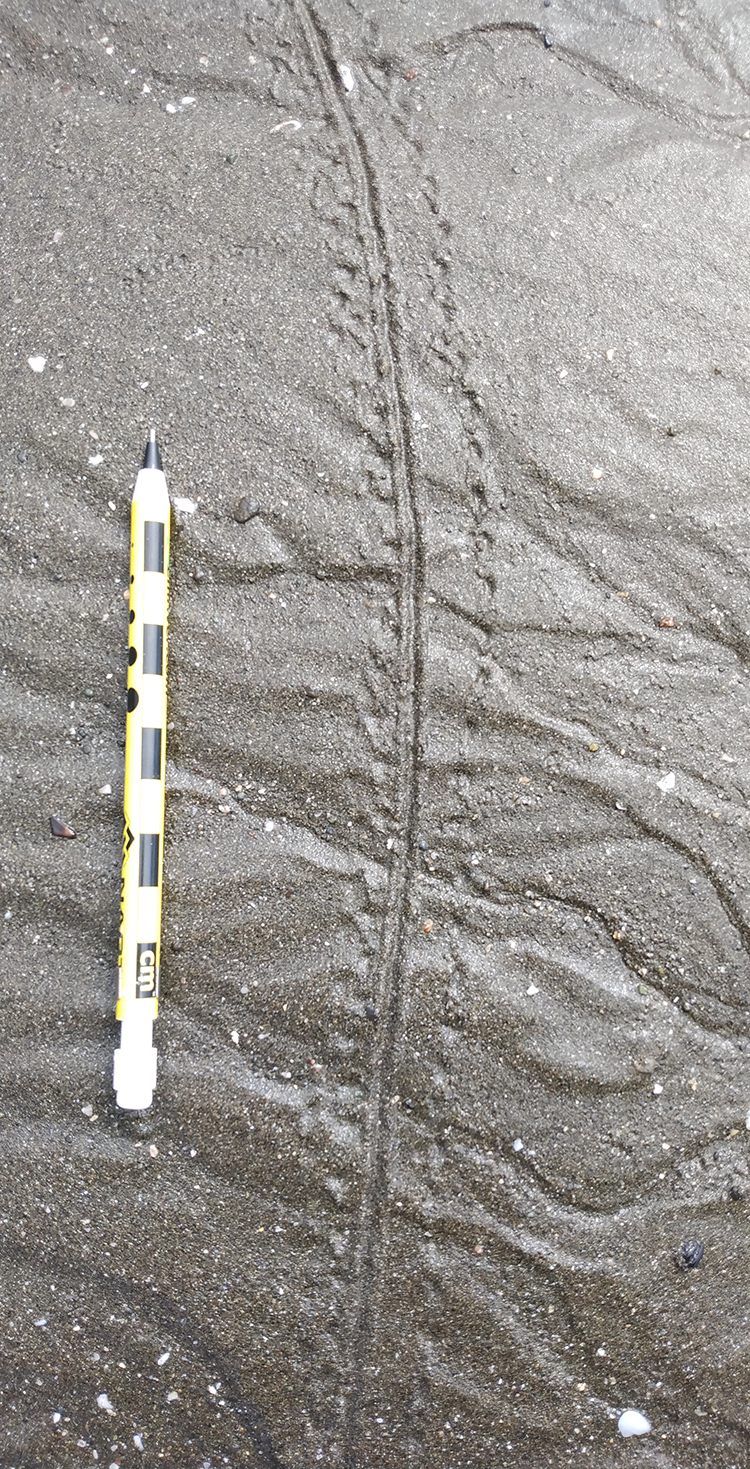
Note the two parallel lines of tracks laid down by little feet, and the central groove that overprints them. It reminded me very much of this similar arrangement, from near St. Andrews in Scotland, but: (1) this is the underside of a bed rather than its upper surface, and (2) it is of a rather more substantial magnitude…
28 November 2022
Getting ripped
I traveled to Costa Rica over the Thanksgiving holiday, and enjoyed exploring the coastal outcrops near Esterillos in Puntarenas province. Before I get to the rocks, though, I thought I’d share a bit of the patterns on the sand on the beach. These ripples, for instance:
They’re as large as pythons!
And in this set, large antidunes are bedecked in a smaller surficial “skin” of oscillation ripples:
I didn’t include a sense of scale in either of these ripple photos because I just found them so strikingly pretty, and didn’t want to mar the beauty by sticking any science in there.
At another location, at low tide, the land was seeping groundwater out through the beach, resulting in a neat ‘braided’ pattern made plain by the high contrast between biogenic particles and the volcaniclastic bulk of the sediment. Check it out – this view is looking “upstream” but I’m not sure there’s anything diagnostic here to show that for sure.
I love stuff like this; I spent a lot of quality time watching standing waves move upstream (antidunes migrating) and neat little mini-deltas forming and being eroded, endless adjustments of little bits of the Earth system under the influence of moving water.
27 November 2022
Book report
An Immense World, by Ed Yong
 Pulitzer Prize winner Ed Yong’s second book has arrived, and it’s about animal senses. Early on, he introduces the concept of the Umwelt as a way of thinking about the totality of an individual organism’s sensory perceptions. You can smell, taste, hear, touch, and see, for instance, but you can’t sense ultraviolet light, or infrasound, or magnetic fields. Many other animals can – and so their Umwelten are different from yours. What is it like to be a bat? Yong explores this question further than Thomas Nagel was able to, and it’s a fascinating journey. Yong writes with confidence, empathy, and thoughtful consideration. He visits the laboratories and field sites of dozens of biologists who are probing the limits of animal senses, and comes into direct contact with diverse creatures – otters and star-nosed moles, moths and songbirds and octopuses — and bats. On the whole, the book is a very refreshing read, full of wonder and humor as well as sober appreciation for the perspectives of others. One thing I’ll note however in the way of criticism: about 1/10th of the book is footnotes! There are a tremendous number of tangential comments or quirky insights or tantalizing connections that don’t fit into the main sweep of the narrative, and Yong definitely invokes The Footnote as a tool for resolving that conundrum, over and over again!
Pulitzer Prize winner Ed Yong’s second book has arrived, and it’s about animal senses. Early on, he introduces the concept of the Umwelt as a way of thinking about the totality of an individual organism’s sensory perceptions. You can smell, taste, hear, touch, and see, for instance, but you can’t sense ultraviolet light, or infrasound, or magnetic fields. Many other animals can – and so their Umwelten are different from yours. What is it like to be a bat? Yong explores this question further than Thomas Nagel was able to, and it’s a fascinating journey. Yong writes with confidence, empathy, and thoughtful consideration. He visits the laboratories and field sites of dozens of biologists who are probing the limits of animal senses, and comes into direct contact with diverse creatures – otters and star-nosed moles, moths and songbirds and octopuses — and bats. On the whole, the book is a very refreshing read, full of wonder and humor as well as sober appreciation for the perspectives of others. One thing I’ll note however in the way of criticism: about 1/10th of the book is footnotes! There are a tremendous number of tangential comments or quirky insights or tantalizing connections that don’t fit into the main sweep of the narrative, and Yong definitely invokes The Footnote as a tool for resolving that conundrum, over and over again!
The Catskill Delta, edited by Donald Woodrow and William Sevon
 A Geological Society of America special “paper” (#201), this volume includes 17 papers (and one abstract without the paper!), all about various aspects of the middle- to upper-Devonian stratigraphy and paleontology of the Catskill clastic delta in the Appalachian Basin. I read it last weekend on the porch, enjoying delving into paper after paper about a common theme, all that sand and mud shed off the Acadian Orogen. This isn’t the typical sort of light reading I’d choose for a sunny Saturday afternoon, but a colleague who recently retired gifted me a box full of books and maps and posters, and there are some real gems in there amid the dust and dross. I’ve been thinking about the Acadian Orogeny more over the past year as I try to synthesize my geological experiences last summer in Maine with other regional data. I’m trying to put together a coherent “case study” on the Acadian for my free, online Historical Geology text”book,” and this volume stimulated my thinking about the clastic signature of that mountain-building event. Of particular interest were the black shales that are now the source of so much natural gas in places like western Pennsylvania.
A Geological Society of America special “paper” (#201), this volume includes 17 papers (and one abstract without the paper!), all about various aspects of the middle- to upper-Devonian stratigraphy and paleontology of the Catskill clastic delta in the Appalachian Basin. I read it last weekend on the porch, enjoying delving into paper after paper about a common theme, all that sand and mud shed off the Acadian Orogen. This isn’t the typical sort of light reading I’d choose for a sunny Saturday afternoon, but a colleague who recently retired gifted me a box full of books and maps and posters, and there are some real gems in there amid the dust and dross. I’ve been thinking about the Acadian Orogeny more over the past year as I try to synthesize my geological experiences last summer in Maine with other regional data. I’m trying to put together a coherent “case study” on the Acadian for my free, online Historical Geology text”book,” and this volume stimulated my thinking about the clastic signature of that mountain-building event. Of particular interest were the black shales that are now the source of so much natural gas in places like western Pennsylvania.
The 1619 Project, edited by Nikole Hannah-Jones
 A collection of essays (and even some short fiction and poetry) that reframes American history in light of the practice of chattel slavery. Starting in 1619 in Jamestown, British colonists (and later their political descendants, Americans) enslaved Africans, and that isn’t just an incidental historical act that can be swept under the rug because it makes modern Americans uncomfortable. Instead, Hannah-Jones and her coauthors argue, it is the central fact of American culture and governance, and at the very heart of our nation’s story. Despite the abolition of slavery, the cruelty and division it fostered are (forever??) baked into the American experience. This is a book that doesn’t flinch from that perspective, but explores it deeply and thoughtfully. The essays included explore politics, economics, capitalism, citizenship, and justice, all putting slavery front and center, where it makes sense in explaining myriad features of the modern American experience. The book argues that this is proper and necessary to really get how this country functions. American history didn’t start in 1776, Hannah-Jones and her co-authors assert, it started in 1619.
A collection of essays (and even some short fiction and poetry) that reframes American history in light of the practice of chattel slavery. Starting in 1619 in Jamestown, British colonists (and later their political descendants, Americans) enslaved Africans, and that isn’t just an incidental historical act that can be swept under the rug because it makes modern Americans uncomfortable. Instead, Hannah-Jones and her coauthors argue, it is the central fact of American culture and governance, and at the very heart of our nation’s story. Despite the abolition of slavery, the cruelty and division it fostered are (forever??) baked into the American experience. This is a book that doesn’t flinch from that perspective, but explores it deeply and thoughtfully. The essays included explore politics, economics, capitalism, citizenship, and justice, all putting slavery front and center, where it makes sense in explaining myriad features of the modern American experience. The book argues that this is proper and necessary to really get how this country functions. American history didn’t start in 1776, Hannah-Jones and her co-authors assert, it started in 1619.
Some Assembly Required, by Neil Shubin
 The author of the superlative Your Inner Fish (and the underwhelming sequel The Universe Within) returns with a third book. I loved it – it delves into evolutionary developmental biology (evo devo) and sources of evolutionary novelty (the grist for natural selection’s mill) that are distinct from mere point mutations. Jumping genes, endosymbioses, viruses inserting their code into the middle of our code, changes in embryo timing – it’s complicated. But the past several hundred years, and particularly the past 75, have led to astounding insights that show us how genes manifest in the building of bodies. Shubin does a great job profiling key scientists whose thoughtful observations and clever experiments revealed key mechanisms by which these mechanisms functioned outside the basic “central dogma” of modern evolutionary theory. The story is more complicated than we had supposed, but its complications are fascinating and insightful. Top notch science writing by Shubin. Highly recommended.
The author of the superlative Your Inner Fish (and the underwhelming sequel The Universe Within) returns with a third book. I loved it – it delves into evolutionary developmental biology (evo devo) and sources of evolutionary novelty (the grist for natural selection’s mill) that are distinct from mere point mutations. Jumping genes, endosymbioses, viruses inserting their code into the middle of our code, changes in embryo timing – it’s complicated. But the past several hundred years, and particularly the past 75, have led to astounding insights that show us how genes manifest in the building of bodies. Shubin does a great job profiling key scientists whose thoughtful observations and clever experiments revealed key mechanisms by which these mechanisms functioned outside the basic “central dogma” of modern evolutionary theory. The story is more complicated than we had supposed, but its complications are fascinating and insightful. Top notch science writing by Shubin. Highly recommended.
The Belt Series in Montana, by Clyde P. Ross
 Another “paper” that’s really a book. This one is USGS “professional paper 346,” published in 1963. As with the previous volume, it’s one that I recently “inherited” from a colleague who retired. I find the Belt Supergroup fascinating and enticing, and I read this 112 page volume cover to cover. It maybe be more than half a century old, but the Belt is older! It holds up very well, and I found particularly fascinating the long and inconclusive discussion of whether the Belt represents “marine” or “lacustrine” deposition, as well as the extensive listing of Belt-age equivalents in other parts of the North American continent, and what light they can shed on the Belt. I found inspiration here in making deliberate visits to some of these Mesoproterozoic strata that I haven’t yet seen, and thinking about the different world in which they were laid down.
Another “paper” that’s really a book. This one is USGS “professional paper 346,” published in 1963. As with the previous volume, it’s one that I recently “inherited” from a colleague who retired. I find the Belt Supergroup fascinating and enticing, and I read this 112 page volume cover to cover. It maybe be more than half a century old, but the Belt is older! It holds up very well, and I found particularly fascinating the long and inconclusive discussion of whether the Belt represents “marine” or “lacustrine” deposition, as well as the extensive listing of Belt-age equivalents in other parts of the North American continent, and what light they can shed on the Belt. I found inspiration here in making deliberate visits to some of these Mesoproterozoic strata that I haven’t yet seen, and thinking about the different world in which they were laid down.



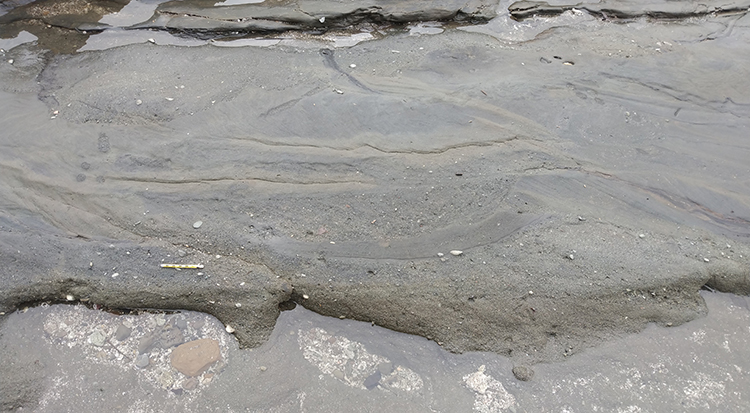 (Click to enlarge)
(Click to enlarge)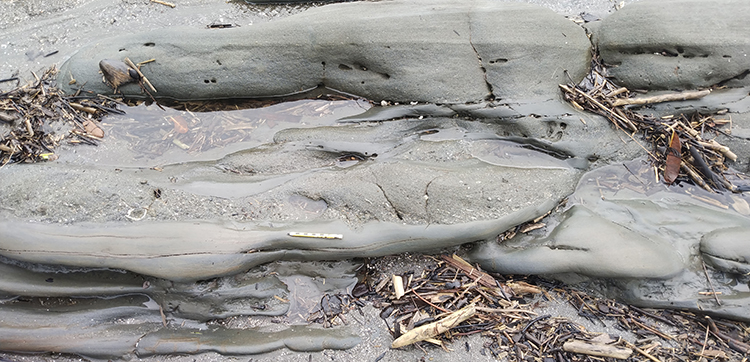 (Click to enlarge)
(Click to enlarge)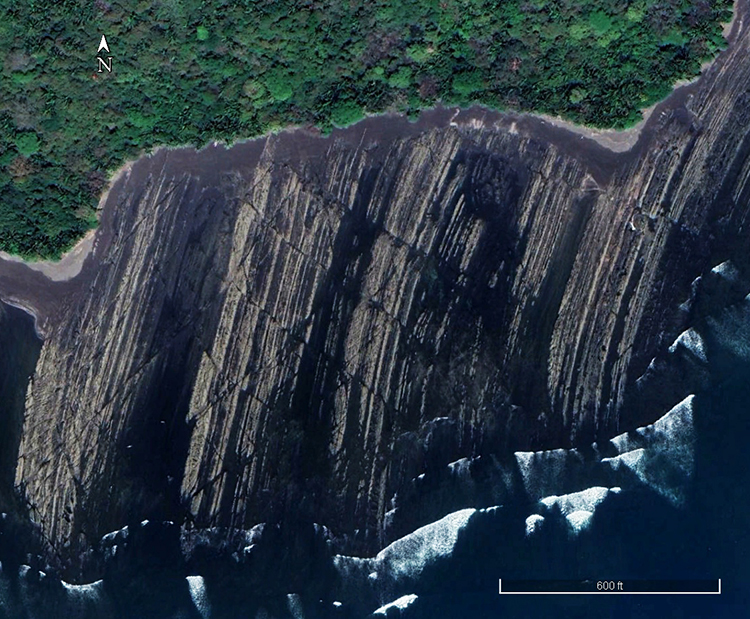 (Click to enlarge)
(Click to enlarge)
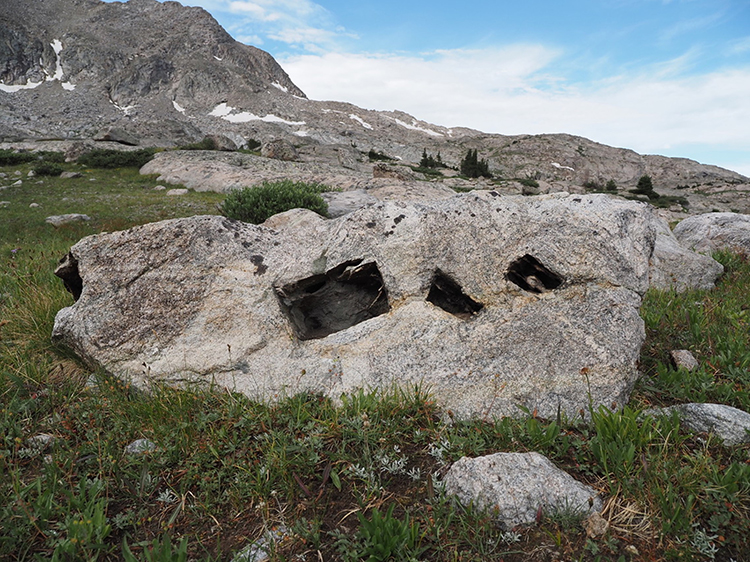
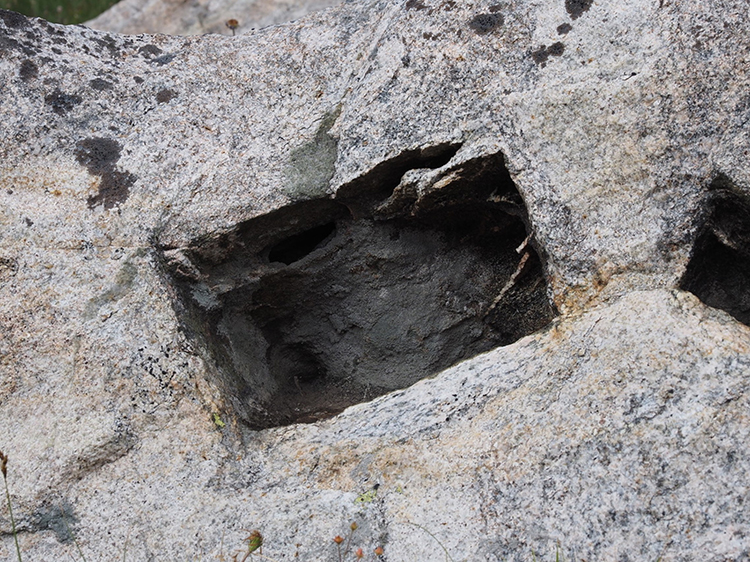



 Callan Bentley is Associate Professor of Geology at Piedmont Virginia Community College in Charlottesville, Virginia. He is a Fellow of the Geological Society of America. For his work on this blog, the National Association of Geoscience Teachers recognized him with the James Shea Award. He has also won the Outstanding Faculty Award from the State Council on Higher Education in Virginia, and the Biggs Award for Excellence in Geoscience Teaching from the Geoscience Education Division of the Geological Society of America. In previous years, Callan served as a contributing editor at EARTH magazine, President of the Geological Society of Washington and President the Geo2YC division of NAGT.
Callan Bentley is Associate Professor of Geology at Piedmont Virginia Community College in Charlottesville, Virginia. He is a Fellow of the Geological Society of America. For his work on this blog, the National Association of Geoscience Teachers recognized him with the James Shea Award. He has also won the Outstanding Faculty Award from the State Council on Higher Education in Virginia, and the Biggs Award for Excellence in Geoscience Teaching from the Geoscience Education Division of the Geological Society of America. In previous years, Callan served as a contributing editor at EARTH magazine, President of the Geological Society of Washington and President the Geo2YC division of NAGT.